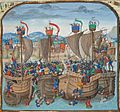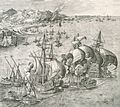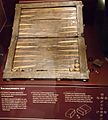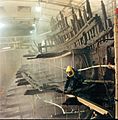Mary Rose facts for kids
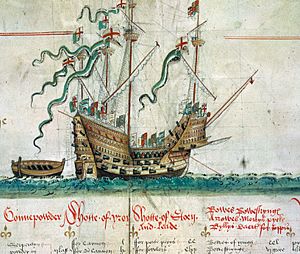
The Mary Rose was a famous warship that belonged to King Henry VIII of England. She was a powerful ship from the 16th century. In 1545, the Mary Rose sank during a battle with a French fleet.
For hundreds of years, the Mary Rose lay at the bottom of the sea. In 1979, a group called the Mary Rose Trust was formed. They worked hard to bring the ship back to the surface. In 1982, they successfully raised the Mary Rose from the sea. Then, in 1994, they began the long process of preserving her so she wouldn't fall apart.
Today, you can see the remains of the Mary Rose in Portsmouth, England. She is displayed alongside other famous ships like the HMS Victory and HMS Warrior.
Why the Mary Rose Sank
The exact reason why the Mary Rose sank is still a bit of a mystery. There are a few ideas about what happened during the battle in 1545.
One idea is that the ship had its gun ports open. These are the openings where the cannons would stick out to fire at the French ships. The Mary Rose might have turned quickly to aim its cannons at another enemy ship. When it turned, the men on board might not have closed the gun ports fast enough. This could have allowed a lot of sea water to rush into the ship, causing it to tip over and sink quickly.
Another theory suggests that strong winds blew during the battle. These winds could have made the ship unstable and caused it to tip over, leading to its sinking. Whatever the exact cause, the sinking of the Mary Rose was a sad event for King Henry VIII's navy.
Images for kids
-
The Embarkation of Henry VIII at Dover, a painting that commemorated King Henry's voyage to the Field of the Cloth of Gold in 1520, painted in 1540. The vessels in the painting are shown decorated with wooden panels similar to those that would have been used on the Mary Rose on special occasions.
-
Peter Pomegranate, the sister ship of the Mary Rose
-
The Mary Rose as depicted in the Anthony Roll. The distinct carrack profile with high "castles" fore and aft can clearly be seen. Although the number of guns and gun ports is not entirely accurate, the picture is overall an accurate illustration of the ship.
-
An illustration from a French edition of the Froissart Chronicle depicting the battle of Sluys in 1340. The picture clearly shows how medieval naval tactics focused on close combat fighting and boarding.
-
Two culverins and two demi-cannons from the Mary Rose on display at the Mary Rose Museum
-
A cast bronze culverin (front) and a wrought iron port piece (back), modern reproductions of two of the guns that were on board the Mary Rose when she sank, on display at Fort Nelson near Portsmouth
-
Vice-Admiral George Carew, who perished with the Mary Rose; contemporary miniature by Hans Holbein the Younger
-
Carracks, similar to the Mary Rose, attacked by highly manoeuvrable galleys; engraving by Frans Huys after a design by Pieter Bruegel the Elder, c. 1561
-
Drawing of the French admiral, Claude d'Annebault, commander of the French naval force that launched the attack on the Isle of Wight; François Clouet, January 1535
-
Southsea Castle, from where Henry VIII witnessed the last battle and demise of the Mary Rose. The castle has been heavily altered since that time.
-
Charles Brandon, brother-in-law of King Henry VIII through marriage with Mary Tudor, who took charge of the failed salvage operation in 1545
-
Illustration from a treatise on salvaging from 1734, showing the traditional method of raising a wreck with the help of anchors and ships or hulks as pontoons, the same method that was attempted by the Tudor era salvors
-
One of the many rosaries found on the Mary Rose that once belonged to one of the lower-ranking crew members
-
Along with the medical equipment were also personal items belonging to the barber-surgeon, including an expensive silk velvet coif identical to those worn by the members of the Worshipful Company of Barbers in this painting by Hans Holbein the Younger from 1540.
-
Concept plan of the new Mary Rose Museum by Wilkinson Eyre Architects
See also
 In Spanish: Mary Rose para niños
In Spanish: Mary Rose para niños








